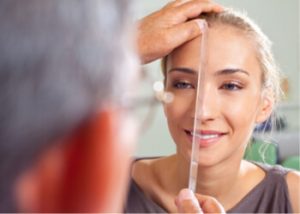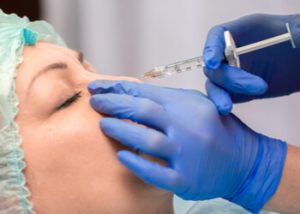Want to have the perfect nose? Social media sometimes mess with how we look at our bodies, making us think less of our assets and focus more on our minor flaws and imperfections. That is why more and more people are turning to cosmetic surgical (or nonsurgical) procedures to somehow change the way they look and feel about themselves. But is plastic surgery, like rhinoplasty, really the best way to go? Let us find out how rhinoplasty works, the benefits we can get from it, the risks and side effects of rhinoplasty, and what people should expect before, during, and after this nose job surgery.
The basics of rhinoplasty
Rhinoplasty as a cosmetic surgery procedure. Rhinoplasty is a nose reshaping surgery that alters the size, form, and height of your nose to make it proportional to your facial features. The cosmetic rhinoplasty surgery is considered a major surgery because of how complex and delicate the structures of the nose are. There are plastic surgeons who are specifically trained to become experts in rhinoplasty surgery, but there are also cosmetic surgeons who have gained experience in performing several nose jobs during their practice.
Rhinoplasty as a reconstructive surgery procedure. People often get mistaken in thinking that getting a nose job is just for aesthetic purposes alone. The truth is, rhinoplasty surgery can also address several medical conditions by correcting the structure and function of the nose. Patients diagnosed with a deviated septum, congenital defects like cleft lip and palate, as well as trauma patients whose injuries involved damage to the nose can benefit in rhinoplasty’s reconstructive measures.
Preparations when deciding to undergo rhinoplasty
If you are considering having a nose job surgery, there are some important things you need to take note of so that your surgical experience would be positively memorable and life-changing.
 Choose the best rhinoplasty surgeon. There are some doctors who are not licensed to perform rhinoplasty but, through previous exposures, are confident that they can give you the same results while having you pay less. Though we cannot say that they are lying, we must advise and recommend that you choose an expert who is registered and recognised by medical associations as having the training and experience to become rhinoplasty specialists.
Choose the best rhinoplasty surgeon. There are some doctors who are not licensed to perform rhinoplasty but, through previous exposures, are confident that they can give you the same results while having you pay less. Though we cannot say that they are lying, we must advise and recommend that you choose an expert who is registered and recognised by medical associations as having the training and experience to become rhinoplasty specialists.
Discuss all your concerns. During your initial consultation, it is essential that you and your chosen surgeon should discuss all the things that are needed to be conferred, like setting realistic goals, the foreseeable risks and complications, and things that you need to expect before, during, and after the procedure. It is said that rhinoplasty will not give you the perfect nose; in fact, there is no such thing as a perfect nose. Let your doctor educate you and help you set realistic goals and expectations for the procedure.
Overall medical evaluation. The nose is a small part of the face, but its surgery is still considered a major procedure. This entails a comprehensive medical assessment that includes your past and present medical history, as well as your family history, just so no unforeseen issues will arise during and after the surgery that can be caused by a pre-existing condition that was not declared beforehand (like bleeding problems or diabetes).
Side effects of rhinoplasty surgery
Let’s make it simple; all surgical procedures, minor or major in nature, would have their fair share of risks and complications, even side effects. Here are some of the negative impacts or side effects of rhinoplasty that most patients complain about:
- Bleeding
- Anaesthesia reactions
- Risk of infection
- Bruising and tenderness
- Swelling (may last or be on-and-off for 12 to 18 months)
- Asymmetry of nostrils
- Loss of sensation (especially on the tip of the nose)
- Prolonged healing (especially for smokers or diabetic patients)
- Limited movement
- Problems with breathing (due to temporary or on-and-off swelling)
- Scarring (for open rhinoplasty)
- Voice alterations (surgery may affect a professional singer’s speech and tone)
- The need for additional or revision surgery
These instances should all be discussed with you by your plastic surgeon even before the procedure starts so that your management and reaction to them once they occur would not be mixed with panic and concern.
Nonsurgical rhinoplasty: Does it exist?
 When patients who want to have cosmetic revisions suddenly realise the seriousness of getting a rhinoplasty surgery, they somehow hesitate to push through with the procedure, although they really want to achieve the benefits that it would give them. This is where nonsurgical rhinoplasty enters the picture. Cosmetic clinics and surgeons are now able to offer this procedure that uses dermal fillers to temporarily reshape the nose.
When patients who want to have cosmetic revisions suddenly realise the seriousness of getting a rhinoplasty surgery, they somehow hesitate to push through with the procedure, although they really want to achieve the benefits that it would give them. This is where nonsurgical rhinoplasty enters the picture. Cosmetic clinics and surgeons are now able to offer this procedure that uses dermal fillers to temporarily reshape the nose.
The benefits of having nonsurgical rhinoplasty
It is noninvasive and does not require surgery. This means fewer side effects and no recovery time needed. You can go back to work as soon as the procedure is over!
The fillers are safe. Most dermal fillers available in the market, like Juvéderm and Restylane Perlane, are all made with biocompatible materials that perfectly suit and are harmless to the body.
The transformation is instant. After the procedure, you can immediately see the change in the shape, size, or height of your nasal profile.
The effects are temporary. It may be seen as an advantage, especially for patients who are still unsure if they would want to have a rhinoplasty surgery of not. Once the effects of the dermal fillers subside, they may decide if they would just stick to the way their natural noses look, or they would push through with surgery to get the permanent effect of the nose job.
It is less expensive. Because nonsurgical rhinoplasty only requires injections of a biocompatible dermal filler (most common is hyaluronic acid), it is considered an outpatient procedure, which means there is no need for hospitalization and other additional costs that make the rhinoplasty price tag go as high as $20,000!
Liquid nose job: The side effects of rhinoplasty
With the above-mentioned benefits of nonsurgical rhinoplasty, you would think that there will be no problems with this procedure, right? Well, not necessarily. There are still risks and side effects that you can expect when getting this ‘liquid nose job’.
The effect is limited. The sole purpose of nonsurgical rhinoplasty for your cosmetic use only, so if you have problems with the structures of your nose that affect its function, this is not the procedure for you.
 Its effect is temporary. Yes, you read it right. The temporary effects of liquid nose job have its ups and downs. The downside is that because the effect fades after a couple of months to a year (depending on the type of filler you and your doctor choose), you would have to get another procedure after if you want to prolong the look it provided you while it is still working.
Its effect is temporary. Yes, you read it right. The temporary effects of liquid nose job have its ups and downs. The downside is that because the effect fades after a couple of months to a year (depending on the type of filler you and your doctor choose), you would have to get another procedure after if you want to prolong the look it provided you while it is still working.
It has its share of side effects. Although this is not an invasive procedure, injection rhinoplasty can still cause redness, skin irritation (to some), tenderness, bruising, and yes, swelling. Although not as evident as that with its surgical counterpart, these side effects may still alarm the patient but should subside in a day or two.
If done incorrectly, it can cause serious adverse effects. According to studies, nonsurgical rhinoplasty, because of its simple nature, is being treated as a minor procedure that does not need the expertise of a surgeon or a specialist. What they do not know is that if the injection is placed on the wrong side of the nose, it can cause blindness (if the fillers are wrongfully injected to the retinal artery) or vascular compromise that may lead to skin death. It is then very important for a patient to choose the right cosmetic surgeon or specialist to handle their procedure and not just anyone else.


Recent Comments